Buck Brothers Construction – Bath Project: Remodel Type I Gold
|
|
|
|

For more information on this project visit www.buck-bros.com. |
|
|
|
|
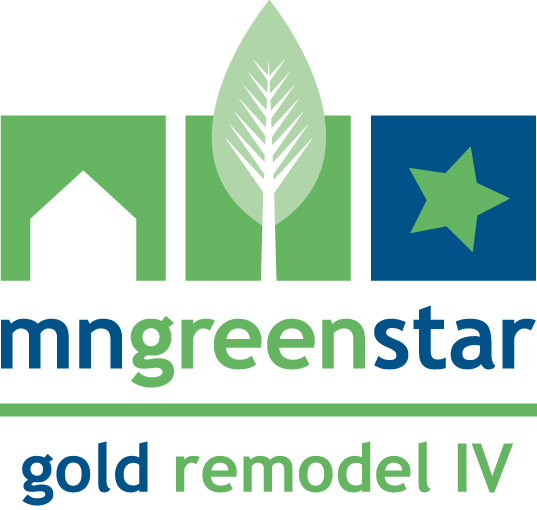 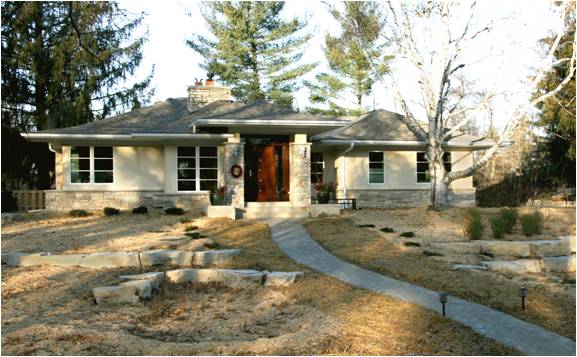
Live Green, Live Smart’s The Sustainable House TM is a participant in Minnesota GreenStar’s Remodeling pilot program and the LEED for Homes Pilot ProjectTM. Live Green, Live Smart has transformed an ordinary post-War rambler in a suburban neighborhood into a Century hour that will be energy efficient, environmentally healthy, respectful of the natural environment, and comfortable for family life as climate and energy resources alter in the coming decades. Environmentally-Conscious Applications The green building materials and techniques as applied to the House are less conspicuous than alternative energy sources, but no less important to our Platinum remodel.
By Peter Lytle, Live Green Live Smart
For more information on this project visit http://livegreenlivesmart.org. |
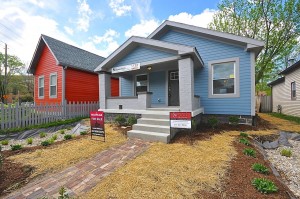 This home located on Elm St. in Indianapolis, IN was an abandoned space, built in 1910, that was bid on for redevelopment through the Southeast Neighborhood Development (SEND) organization’s Transfer and Transform program, which seeks to reinvigorate the community
This home located on Elm St. in Indianapolis, IN was an abandoned space, built in 1910, that was bid on for redevelopment through the Southeast Neighborhood Development (SEND) organization’s Transfer and Transform program, which seeks to reinvigorate the community
“William Wagnon of Green Path Homes had been looking for an opportunity to do a LEED Platinum certified redevelopment on a house that could serve as an example of green building for contractors, home owners and a city in need of sustainability.” The house on Elm presented a perfect opportunity to showcase the economic viability of a green project as well as its added health and enjoyment benefits.
No subsidies or donations were taken to help the project along. “We wanted to do it as a market-rate project so that nobody could make an excuse for not doing it. That’s the point I wanted to make,” Wagnon said.
“The house now features around $7,000 worth of insulation, putting the home’s heating efficiency well-above most standards. The floor plan was changed to allow for a contemporary living style. Raised ceilings and other space improvements provide for maximum storage in the home. A rain garden now sits at the front of the house fed by a drain pipe from the roof. The backyard deck looks out onto a single-car garage, raised planters for growing vegetables and a patch of lawn.” Additionally, 100% of installed plants were drought tolerant further reducing irrigation needs. In total, the outdoor water savings plus the water savings due to the indoor installation of highly efficient faucets, showers, and toilets etc. results in a monthly water savings of 69% based on total water use. We were able to utilize the V4 Homes Workbook: Water Reduction Calculator to derive this number. A copy of the information is attached to the project profile at the bottom of this post.
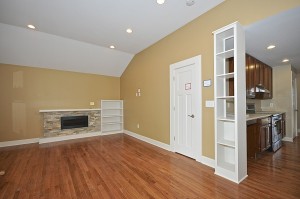 The small 960 sq ft. 2 bedroom 1 bath home is located in an area with outstanding access to community resources such as public transportation. This well sealed home uses energy efficient appliances and is expected to save 47% on energy bills. Insulated piping adds to the efficiency of this home.
The small 960 sq ft. 2 bedroom 1 bath home is located in an area with outstanding access to community resources such as public transportation. This well sealed home uses energy efficient appliances and is expected to save 47% on energy bills. Insulated piping adds to the efficiency of this home.
A central HVAC system equipped with an additional dehumidification mode adds to the health of the home along with the use of hardwood with a preference for FSC certified woods.
So much care was put into this home on Williams blog he writes … “Walter, who has does the exterior sheathing, rigid foam insulation and now the siding work is putting flashing tabs behind each butt joint on the siding. These joints will all be caulked, but it’s just a fact that caulk fails in a couple of years. But with the flashing tabs, any water that penetrates is redirected right back to the outside.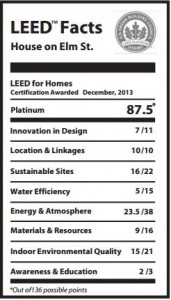
Brad nailed every shingle of the roof by hand. Yes, it takes much longer, but he knows each one is set. In building the soffit end caps, he cut fairly complex pieces so it could be 1 piece of solid wood, instead of having multiple joints that would require caulking.”
This project was the first residential home in the area to achieve the prestigious LEED Platinum certification.
News Post Featuring this Project
Green Path Home Website and Blog
This newly constructed LEED Silver Home is located on the north side of Ann Arbor, on a 5 acre lot. The home is 4,500 square feet with 6 bedrooms, 2 ½ baths, and has a walk-out basement.
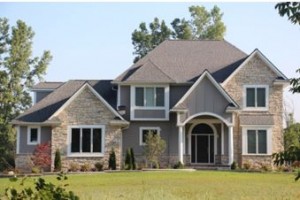 The project team wanted to build a very energy efficient, comfortable home for the family to raise their children in. Throughout the project, the team emphasized purchasing sustainable materials including adhesives and sealants with zero Volatile Organic Compounds (VOC’s) to attain a higher air quality. They worked with a HERS rater to hone in on their energy efficiency strategies. Northern Michigan Oak hardwood flooring was used throughout the first floor of the home because of its close proximity to the project. All carpeting and underlayment were Green Label Plus certified by the GreenGuard Certification Institute. Blown-in cellulose insulation, which is made up of 100% recycled newspaper fiber, was used instead of fiberglass. The fitness room boasts a 100% recycled rubber flooring and the TREX deck had a high percentage of recycled materials as well. A drought resistant turf grass mix limited irrigation requirements, as well as a wildflower mix on the perimeter of the turfed-in area. Additionally, only native species of bushes and trees were installed. The system is controlled by a RainBird Sensor that automatically adjusts the irrigation schedules if it senses rainfall.
The project team wanted to build a very energy efficient, comfortable home for the family to raise their children in. Throughout the project, the team emphasized purchasing sustainable materials including adhesives and sealants with zero Volatile Organic Compounds (VOC’s) to attain a higher air quality. They worked with a HERS rater to hone in on their energy efficiency strategies. Northern Michigan Oak hardwood flooring was used throughout the first floor of the home because of its close proximity to the project. All carpeting and underlayment were Green Label Plus certified by the GreenGuard Certification Institute. Blown-in cellulose insulation, which is made up of 100% recycled newspaper fiber, was used instead of fiberglass. The fitness room boasts a 100% recycled rubber flooring and the TREX deck had a high percentage of recycled materials as well. A drought resistant turf grass mix limited irrigation requirements, as well as a wildflower mix on the perimeter of the turfed-in area. Additionally, only native species of bushes and trees were installed. The system is controlled by a RainBird Sensor that automatically adjusts the irrigation schedules if it senses rainfall.
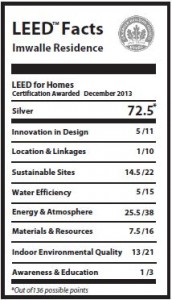 A Home Energy Rating Standard (HERS) Score of 44 was achieved for this house, which makes it in the top 10% of MI homes. The score means that the home is 56% more efficient than a conventionally built new home, and 42% more efficient than Energy Star’s standard for homes. To give you an understanding of what this equates to, the energy bill for this 4,500 sq. ft home during the month of July, was $110 for both electric and gas. The project team chose to focus on the Energy & Atmosphere and Indoor Environmental Quality (IEQ) credit areas to compensate for the sacrifice of Location & Linkages credits due to the projects distance from an urban setting. The high rating of LEED Silver was achieved by taking a whole systems design approach to building, and eliminating any weak points in the house.
A Home Energy Rating Standard (HERS) Score of 44 was achieved for this house, which makes it in the top 10% of MI homes. The score means that the home is 56% more efficient than a conventionally built new home, and 42% more efficient than Energy Star’s standard for homes. To give you an understanding of what this equates to, the energy bill for this 4,500 sq. ft home during the month of July, was $110 for both electric and gas. The project team chose to focus on the Energy & Atmosphere and Indoor Environmental Quality (IEQ) credit areas to compensate for the sacrifice of Location & Linkages credits due to the projects distance from an urban setting. The high rating of LEED Silver was achieved by taking a whole systems design approach to building, and eliminating any weak points in the house.
Sustainable architecture is nothing if it’s not deeply rooted in the surrounding community. Whether it’s sculpture by a local artist or an intimate concert at the Cedar Cultural Center, 7west (1800 Washington) celebrates the satisfying connections that come from Seven Corners living. For residents, LEED is a seal of quality, providing peace of mind that they are living in a home designed to deliver fresh air indoors and improved water and energy efficiency.
The 7west building has several green features that its renters find attractive. Each floor has recycling and organic composting available for the tenants. Green roofs and terraces provide relaxing greenspace, while a white membrane roof provides additional energy efficiency.
 The building also features a passive solar design and high efficiency lighting. Tenants are encouraged to utilize alternative transportation with convenient onsite bike storage set in an easily walkable community. The apartments are located within a half mile of public transit services which provide at least 60 rides per week day. However, those that do drive vehicles regularly are provided garage space with continuous exhaust to minimize pollutants that could leak into the residence and affect the indoor air quality. Inside the apartments Low-VOC paints hardwood flooring, and sustainable cabinetry provide for a healthy, natural, and sensible interior environment.
The building also features a passive solar design and high efficiency lighting. Tenants are encouraged to utilize alternative transportation with convenient onsite bike storage set in an easily walkable community. The apartments are located within a half mile of public transit services which provide at least 60 rides per week day. However, those that do drive vehicles regularly are provided garage space with continuous exhaust to minimize pollutants that could leak into the residence and affect the indoor air quality. Inside the apartments Low-VOC paints hardwood flooring, and sustainable cabinetry provide for a healthy, natural, and sensible interior environment.
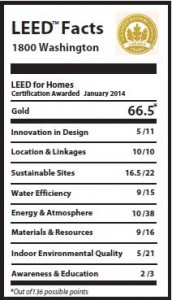
The Buildings landscaping was created with 100% drought tolerant plants. Rain barrels provide the irrigation needed to water the green roof and plants. As a former brownfield this lot has come a long way. Additional LEED points were awarded to the project for its density of 100.9 units per acre.
That’s just the start. Sunny gathering spaces, private study nooks, yoga and fitness studios, and common areas with billiards, fire pits, and entertainment centers recognize that many residents need a respite from the stress of daily life. Innovative Chinese Feng shui design creates a positive atmosphere. The LEED verification team included Jimmie Sparks, Rick Cobbs, and Jason LaFleur of Eco Achievers.
Download and Share the 1800 Washington Project Profile – PDF
“This $28.5M project involved the construction of two new student housing buildings for Central Michigan University’s (CMU) graduate school. Hoping to emulate apartment living to attract the students who might otherwise choose to
live off-campus, each unit includes private bathrooms, kitchens and laundry facilities—with a mix of one, two and four bedroom units throughout the two structures, with 164 beds total between the two buildings.
The buildings were designed to emulate the Gothic architecture present on campus and the design and construction teams ensured that LEED sustainable features incorporated into the design were properly integrated. Large windows
were added to provide occupants with daylight in regularly occupied areas. A campus-wide green housekeeping program was implemented. Regionally manufactured materials containing recycled content were used extensively throughout the project. Equipment was selected to ensure that refrigerants would cause minimal damage to the atmosphere. Additionally, all HVAC and electrical systems were commissioned and certified that they were installed per specification and working as designed. The design also limits disruption of natural hydrology and all but eliminated pollution and contaminants from stormwater run-off. Universal design practices and sustainable design measures were integrated into the design to create an energy efficient complex recognized by its tenants as a great place to live and by the community as a model for sustainable living, earning the coveted LEED for Homes Platinum Certification.
SUSTAINABLE HIGHLIGHTS
 SUSTAINABLE SITE
SUSTAINABLE SITE
The pedestrian scale buildings support CMU’s and the City of Mount Pleasant’s mutual goal of a walkable community. The new Graduate Housing units are located on the north end of campus on Bellows Street, just steps from the Health Professions/College of Medicine building and close to Mission Street as well as downtown Mt. Pleasant.
WATER EFFICIENCY
The landscaping was designed to require 50% less irrigation, reducing the use of potable water. In addition, a 33% reduction in potable water and sewage usage was achieved by careful selection of water efficient plumbing fixtures, faucets, and flush valves.
ENERGY EFFICIENCY
The overall energy performance of a new building can not be measures until after the building has been built. Thus, the energy performance of a building must be predicted using energy analysis software. The Residential Energy Services Network has developed a set of guidelines for accessing the relative energy performance of these units. Commissioning of all HVAC, lighting and domestic water systems were conducted to ensure that all systems operate as designed. All equipment was selected to cause minimal damage to the atmosphere.
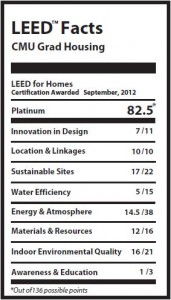
MATERIALS AND RESOURCES
During construction, 94% of all construction waste was reclaimed and recycled. Sources for the building construction materials were evaluated, recycled content materials make use of materials that would otherwise be deposited within landfills. The use of local materials support the local economy and reduce the harmful impacts of long-distance transportation.
INDOOR ENVIRONMENTAL QUALITY
An indoor air quality (IAQ) plan was implemented and low-emitting materials were selected in order to reduce any adverse effects on the IAQ once the building was occupied. The HVAC system was designed to meet the minimum IAQ requirements. No smoking is permitted within 25 feet of any air intake louvers. Low VOC (volatile organic compound) materials such as paints, carpets, sealants, adhesives, and casework were employed in order to provide a healthy indoor environment. The HVAC system was designed to maintain temperatures and humidity in accordance with ASHRAE standard 55-2007.”
The Christman Company – Builder/Contractor & Neumann / Smith Architects
Thanks to Jetson Green for sharing this awesome post! (Article written by Christine Walsh on Nov. 28, 2013)
Architect Virge Temme of Sturgeon Bay, Wisconsin recently received the LEED Platinum for Homes certification for a private residence she designed near Gills Rock. The home was built by Bay Lakes Builders, and the plans were based on the collaboration of all members of the construction and design team so as to ensure proper integration of all systems. The electric and fuel bills for this 2,600-square-foot house were less than $30 per month on average during its first year. This is only the seventh home in Wisconsin to receive the LEED Platinum certification.
The building process started with the excavation of the meadow where the house stands, while the top soil was stockpiled and used for final grading later. Once the foundation was complete, the foundation forms were stripped and the below-slab plumbing and electrical runs installed. The builders continued with laying thermal tarp to protect the home from freezing rains. This was followed by the installing of under-slab insulation. All the joints were staggered and sealed in this process to prevent air movement between layers. Furthermore, all the penetrations through insulation were foam sealed, which protects against cold seepage and potential Radon gasses.
The roof was then installed, using 16″ I-joists to reduce thermal transmission and to provide additional insulation depth. The I-joists were placed directly over the studs below and the framed walls with studs at 24″ on center to reduce redundant top plate, which also reduced the overall framing materials need. The rafters were then screwed and strapped to studs to provide additional protection from wind. All the intersections were then foam-sealed.
To provide a continuous envelope 3/8″ OSB was added to the under side of rafters. Double 2-4 plates were screwed below the rafters to provide an electrical chase, eliminating the need for roof penetrations. The builders also used ladder framing, which greatly reduced the amount of redundant materials at wall-to-wall connections. Double-wall construction also eliminated thermal bridging and provided space for additional insulation.
The house has insulation values of R-45 for walls, R-60 for the roof, and R-30 for ground insulation. Together with passive solar orientation and specially-coated windows to introduce solar warming, and which also feature overhangs to protect from summer over-heating, there is no need for a furnace or a boiler for space heating.
Other sustainable features of the home include:
– Sustainably-harvested framing materials
– Recycled/recyclable metal siding, roofing and insulation
– Drought-tolerant plants replanted around the home
– Rain gardens for roof runoff
– Only low- or no-VOC paints, adhesives and insulation were used to ensure better air quality
– Floors are made of concrete and sustainably harvested bamboo
– Only highly efficient appliances, lighting fixtures, and plumbing were installed
– The building process resulted in almost no construction waste
View LEED project Profile Here
Article tags: alternative energy, Development, energy efficiency, green building, LEED,leed certification, LEED Platinum, modern architecture, modern design, passive house, residential, water efficiency
GreenHome Institute
ATTN José Reyna
1451 Lake Drive SE, #6484
Grand Rapids, MI 49516
Tel: (616) 458-6733
Email: info@greenhomeinstitute.org
